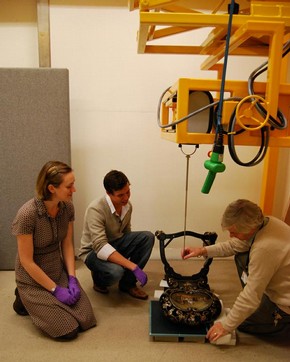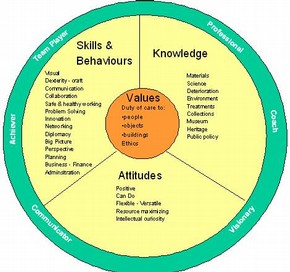Conservation Journal
Spring 2011 Issue 59
V&A launches new National Conservation Diploma and the Conservator Development Programme
Sandra Smith
Head of Conservation, Collection Services
The new V&A Conservation Diploma, awarded level 4 national status in December 2009 by the UK’s Qualifications and Curriculum Development Agency (QCDA), is available to all staff and volunteers in the sector through the V&A Cultural Heritage Assessment Centre. The aim of the qualification is to develop conservators with high competence in a specialist area of conservation and an ability to apply this knowledge creatively. This diploma also fills a recognised gap between initial training and the development of expert skills for the conservation professional.
This modular work-based learning/training programme is unique within conservation in the UK. The structure of the Conservation Diploma allows qualified conservators, and other design-based graduates to develop expert knowledge and practical skills in one of eight specialist areas of conservation:
- Upholstery conservation
- Textile mounting
- Textiles conservation
- Furniture conservation
- Preventive conservation
- Sculpture conservation
- Metals conservation
- Ceramic, glass and enamel conservation
The training also includes organisational practice, museology, and personal skill development to ensure that the conservator applies their knowledge in helping organisations realise the wider goals of making collections and staff expertise more accessible to the widest audience.
The training is aligned with the professional skills identified under The Institute of Conservation (ICON) Professional Accreditation of Conservator-Restorers (PACR) scheme. At the end of the training there are opportunities to use this unitised programme to contribute towards a work-based degree. We are delighted that the Worshipful Company of Needlemakers are supporting this training initiative through a Needlemakers Bursary and a prize for students who are major users of needles within their conservation practice.
Responses from the profession have been positive with a number of expressions of interest from private conservation practices to see how the Conservation Diploma could be used to develop their staff skills. We are currently looking at how the V&A can support external students, by providing opportunities to participate in training days and conservation projects.
The Conservation Development Programme is the implementation of the Conservation Diploma within the V&A. Working alongside practicing conservators, curators and other colleagues on the day-to-day business of the Museum, this modular work-based learning will span three years. For the duration of the training the trainee will be recognised as a member of the V&A staff and will receive a salary.
Initial emphasis has been on offering places within the conservation studios in the specialisms for which there is currently either no training course or where the specialism forms only a small part of broader conservation training. Here the V&A recognises that there is a need to develop high level practical competency to ensure that appropriately-skilled conservators are available, in the future, to work on the UK’s national collections. The assistant conservators will be encouraged to work towards professional accreditation during their programme.
Underpinned by additional museology training and an understanding of the V&A context, the conservator will develop an outcome-focussed approach to conservation. They will understand how their professional knowledge and expertise contributes to and enables national collections to be used more creatively, to be understood more comprehensively, and to be preserved more sustainably. As members of staff, the trainees will be developed in accordance with the V&A’s Scientist and Conservator Competency model which highlights the importance of developing appropriate behaviours and attitudes towards communication, team working, coaching, achievement, vision and strategy hand in hand with securing professional expertise (Diagram 1).
Two unique opportunities to train as an Upholstery Conservator – supported by the Clothworker’s Foundation – and as a Textile Conservator began in September 2010. The candidates will be working alongside experienced V&A specialist conservators on the Museum’s public programme and on major gallery projects. In Furniture Conservation, the assistant conservator will work on objects for the preparation of the Furniture Galleries, which are due to open in 2012; while the V&A’s new Textile Fashion and Conservation Centre and upgrading some of its textile conservation facilities, provides an excellent opportunity to offer training in the broadest aspects of textile conservation.
Biographies of the Assistant Conservators at the V&A
Alexander Jolliffe – Upholstery
I completed a degree in Furniture Restoration, Conservation and Decorative Arts at Bucks New University, graduating in 2010. During my degree I realised that I wanted to specialise in upholstery. For my final major project I restored a Victorian sofa and amongst other objects conserved a Boulle marquetry plinth for Waddesdon Manor.
After finishing my degree I was fortunate to be offered a three year trainee contract in Upholstery Conservation at the Victorian and Albert Museum. I will be working with the Textile and Furniture Conservation Departments where I am looking forward to my three years of training and the experience and skill that I will gain from this. I feel very privileged to be working at the V&A with people who are experts in their field and am confident that this will give me a firm foundation for my future career in Upholstery Conservation.
Katy Smith - Textiles
My primary degree is in Archaeology, I graduated from University College London having worked on a wide range of excavations, from Neanderthal caves to East London slums. After a short stint as a commercial archaeologist, I chose to pursue conservation.
With a scholarship from the Arts & Humanities Research Council I gained two Masters degrees in general conservation practice. I began volunteering in the Textiles studio at the V&A in 2008, and was fortunate to be taken on as an intern to fulfil the final year of my degree. I also interned at the Museum of London, working in the Decorative Arts section on painted surfaces, metals and ceramics.
My interest in history is a family trait, and I was taught to sew by my mother. I never dreamt that I could combine these interests into a career, and was absolutely thrilled to be offered the position of Textile Conservator Trainee. I am looking forward to gaining specialist knowledge and working with the Museum’s collections.
Spring 2011 Issue 59
- Editorial
- Keep Your Hair On - The development of conservation friendly wigs
- ‘X’ Marks the Spot: The conservation and correction of a Carlo Bugatti Chair
- Removing and re-attaching paper labels
- Will it stand? Morris and Co. wallpaper stand book
- Melting pot: Conserving wax objects in textile conservation
- The effects of fingerprints on silver
- The conservation of John Constable’s six foot sketches at the V&A
- The show must go on: Touring textile and costume objects with hazardous substances
- Dust to dust. Access to access.
- An update on lasers in sculpture conservation
- An approach to conserving study collections
- I’m always touched (by your presence dear)
- The contemporary art of documentation
- The Popart project
- V&A launches new National Conservation Diploma and the Conservator Development Programme
- Editorial board & Disclaimer
- Printer friendly version

